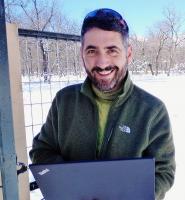Gil Diego
- Investigador Científico
- Departamento: Ecología Evolutiva
- Dirección física: Calle Pinar 25
- Teléfono: +34 91 411 13 28, ext. 980014
- Email: diego.gil@csic.es
- Página web externa: http://www.behavecol.es/es
- Número ORCID: 0000-0003-3179-1987
- Palabras clave:

Investigación
![]()
I'm an evolutionary ecologist. I'm interested in how the behaviour that we see today in animals has been shaped by ecological pressures over evolutionary time. One of my main interests is understanding the physiological mechanisms that shape the adaptive responses of organisms to the environment. In my research group we address these questions in birds in the wild, songbirds in particular.
My research lines can be divided in two groups. Firstly I'm fascinated by bird song. Why does it change so much betwen species and individuals?, how has it been shaped by the acoustic environment to favour its transmission in the different habitats?, what is the link between song, sexual selection and speciation? Right now I'm interested in how birds manage to survive in an anthropic environment, more precisely in how song and singing behaviour are modified in these places to allow birds to communicate despite the huge levels of noise.
My second line of research is the study of maternal effects, in particular the effects of female hormones that are passed from the mother to the offspring within the eggs, and that have effects in the development and fitness of offspring. Our current project is a long term experiment looking at the effects of egg-testosterone in survival, reproduction, dispersal and morphology in the spotless starling (Sturnus unicolor). We conducted the experiment in 2011, and we have been gathering the data for the last 8 years, effectively following a cohort from birth to death.
Working closely with a model system for a long term (such as the starling in my case) allows you to better understand the life history of the species. In the way of the old naturalists, observing animals is the main source of inspiration to come up with new scientific questions while marveling at the plasticity and the beauty of the ways that have evolved to survive in nature.
For more information visit: www.behavecol.es
![]()
Soy un ecólogo evolutivo. Me interesa entender cómo el comportamiento que vemos en los animales en la actualidad ha sido modelado a lo largo de la evolución por las presiones selectivas del medio. Uno de mis intereses fundamentales es comprender los mecanismos fisiológicos que subyacen a las respuestas adaptativas de los organismos. En mi grupo de investigación realizamos sobre todo estudios de campo, usando como sistemas de estudio las aves, por lo general paseriformes.
Mis líneas de investigación pueden dividirse en dos. En primer lugar, me fascina el canto de las aves. ¿Por qué cambia tanto entre especies e individuos?, ¿cómo se ha modificado por el medio para ser transmitido en los distintos hábitats?, ¿cuál es la relación entre el canto, la selección sexual y la especiación?... En la actualidad estoy interesado en cómo las aves se las arreglan para comunicarse en el medio urbanizado, más en concreto en cómo el canto y la forma de cantar son modificados en estos lugares para permitir a las aves comunicarse a pesar de los enormes niveles de ruido.
Mi segunda línea de investigación es el estudio de los efectos maternos, en particular los efectos de las hormonas de la hembra que son transmitidas dentro del huevo a los pollos, y que tienen una influencia en el desarrollo y la adecuación biológica de los mismos. Mi proyecto actual en este sentido es un experimento a largo plazo que examina cómo la variación en los niveles de testosterona en los huevos influye en la supervivencia, la reproducción, la dispersión y la morfología en el estornino negro (Sturnus unicolor). Realizamos este experimento en 2011, y llevamos 8 años recopilando los datos, siguiendo a fin de cuentas toda una generación desde el nacimiento a la muerte.
El trabajar de forma intensiva con un sistema modelo durante tantos años (como el estornino en mi caso) le permite a uno entender mucho mejor la forma de vida de una especie. Observar animales en libertad, tal como hacían los primeros naturalistas, es la principal fuente de inspiración para proponer nuevas preguntas sobre su comportamiento y ecología, al mismo tiempo que uno se maravilla de la plasticidad y la belleza de las formas que han evolucionado los animales para sobrevivir en la naturaleza.
Para más información ver: www.behavecol.es
Publicaciones relevantes
- Gil, D., Honarmand, M., Pascual, J., Perez-Mena, E., Macias García, C. 2015. Birds living near airports advance their dawn chorus and reduce overlap with aircraft noise Behavioural Ecology 26: 435-443
- Klett-Mingo, J.I., Pavón, I. & Gil, D. 2016. Great tits, Parus major, increase vigilance time and reduce feeding effort during peaks of aircraft noise Animal Behaviour 115: 29-34
- Muriel, J., Salmón, P., Nunez-Buiza, A., de Salas, F., Pérez-Rodríguez, L., Puerta, M., Gil, D. 2015. Context-dependent effects of yolk androgens on nestling growth and immune function in chicks of a multi-brooded passerine Journal of Evolutionary Biology
- Muriel, J., Pérez-Rodríguez, L., Puerta, M., Gil, D. 2015. Diverse dose-response effects of yolk androgens on embryo development and nestling growth in a wild passerine Journal of Experimental Biology 218: 2241-2249
Otros investigadores del departamento
- Penteriani Vincenzo
- Alonso Alvarez Carlos
- Alonso Juan Carlos
- Amo de Paz Luisa
- Aparicio Jose Miguel
- Barreda Muñoz Isabel
- Bautista Sopelana Luis M.
- Blanco Hervás Guillermo
- Broggi Obiols Juli
- Canal David
- Carrascal Luis Maria
- Contreras Velasco Adara
- Cuervo Osés José Javier
- de la Concha Maroto Alejandro
- Fargallo Vallejo Juan Antonio
- Fusté i Mach Roger
- Galván Macías Ismael
- García del Río Marina
- Gómez Vicioso Julene
- Jerylle ann Collado Soliven
- López Martínez María Pilar
- Martín Jose
- Melero Romero Pablo
- Merino Rodriguez Santiago
- Morales Fernaz Judith
- Moreno Klemming Juan
- Palacin Moya Carlos
- Palacios Martínez Iñigo
- Perez Badas Elisa
- Rodríguez Airam
- Romero Díaz Cristina
- Romero Haro Ana
- Sanz Cid Juan José
- Ucero Solís Alberto
- Veiga Relea José Pablo
- Wandosell Carrasco Sonia







